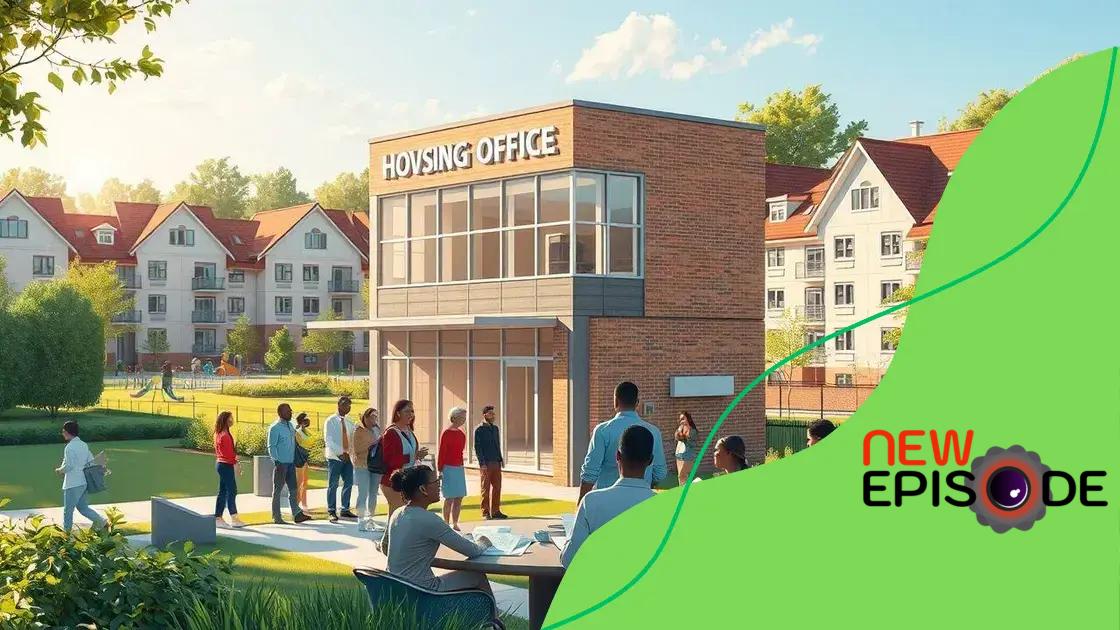How federal government is addressing housing insecurity

The federal government is addressing housing insecurity through initiatives that include increased funding for affordable housing, community collaboration, and innovative solutions focused on sustainability and accessibility.
How federal government is addressing housing insecurity is crucial for many families across the nation. With rising costs and limited availability of affordable homes, solutions are more necessary than ever. Let’s dive into the strategies being implemented.
Overview of housing insecurity in the U.S.
Housing insecurity is an urgent issue affecting millions of Americans today. It encompasses not just homelessness, but also the struggles faced by those who pay more than 30% of their income on rent. This situation creates challenges for families and individuals alike.
Understanding the Scope
In the U.S., many factors contribute to housing insecurity. Economic stress, rising rental prices, and stagnant wages leave many without stable housing. Low-income families and vulnerable populations are disproportionately affected, highlighting the need for comprehensive solutions.
Statistics on Housing Insecurity
- About 11 million households are severely cost-burdened.
- Over 580,000 individuals are homeless on a given night.
- Rent prices have increased by over 30% in many urban areas.
These numbers represent a growing crisis that the federal government is working to address. Efforts to secure affordable housing reflect a societal commitment to ensuring everyone has a place to call home. Additionally, organizations focus on providing resources to help families navigate these challenges.
Programs often include housing vouchers, which help subsidize rent costs, and initiatives to increase the availability of low-income housing. The effectiveness of these programs can vary, but many communities experience beneficial outcomes.
Consequences of Housing Insecurity
The impacts of housing insecurity extend beyond the individual. Families often face health risks, increased stress, and a lack of stability affecting children’s education. When families are stable in their homes, they are more likely to contribute positively to their communities.
Federal policies tackling housing issues
Federal policies tackling housing issues play a significant role in addressing the crisis of housing insecurity in America. These initiatives aim to create more affordable housing options and support low-income families facing challenges.
Key Legislation
Several important laws have been enacted to improve housing access. The Housing Act and the Low-Income Housing Tax Credit are two examples that provide funding for affordable housing projects. These laws encourage developers to build quality housing that is affordable for families in need.
Programs for Assistance
- Section 8 Housing Vouchers: These vouchers help low-income families pay their rent.
- Public Housing: Managed by local housing authorities, this program provides rental assistance to eligible families.
- Community Development Block Grant (CDBG): This grant supports the development of affordable housing and infrastructure.
These programs represent crucial federal efforts to prevent homelessness and improve the quality of life for many Americans. By making housing more accessible and affordable, these policies contribute to stronger communities.
Moreover, the federal government collaborates with local organizations to ensure these policies reach the people who need them most. This partnership is vital in adapting to each community’s specific needs, enhancing the effectiveness of the programs.
Challenges to Implementation
Despite the progress, challenges remain. Limited funding, bureaucratic hurdles, and local resistance can slow the rollout of housing solutions. The government’s commitment to adjusting these policies shows they understand the need for ongoing improvement.
Success stories from government initiatives

Success stories from government initiatives highlight the effectiveness of various programs aimed at addressing housing insecurity. These stories showcase how targeted actions can transform lives and communities.
Positive Outcomes
Government initiatives have led to significant improvements in housing accessibility. For example, the Housing First model prioritizes providing stable housing to the homeless before addressing other issues like employment or health care. This approach has successfully decreased homelessness rates in several cities.
Community Impact
- Increased Affordable Housing: Cities implementing supportive housing developments have seen a rise in available affordable units.
- Empowerment of Residents: Programs that offer job training alongside housing aid help individuals gain steady incomes.
- Partnerships: Collaborations between government, non-profits, and private sectors lead to innovative solutions.
These initiatives show a clear commitment to solving housing issues at multiple levels. Stories from beneficiaries reveal how stable housing positively affects job retention, education, and overall well-being.
Moreover, local governments often tailor solutions to meet community needs, ensuring more people benefit. Examples include cities that have successfully combined transportation assistance with housing programs, enabling residents to commute easily to work.
Examples of Successful Programs
One example is the Rapid Re-Housing program, which helps families quickly find stable housing after experiencing homelessness. This program not only provides the necessary funds but also offers support services to ease the transition and ensure long-term success.
Role of local agencies in housing solutions
Local agencies play a crucial role in developing and implementing housing solutions. They serve as the main point of contact for communities seeking assistance with housing issues.
Function of Local Housing Authorities
Local housing authorities manage public housing programs and provide housing assistance to low-income families. They help determine eligibility for various programs and ensure that residents have access to safe and affordable housing. These agencies also advocate for community needs and work to develop long-term housing strategies.
Collaboration with Community Organizations
- Partnerships: Local agencies often collaborate with non-profit organizations to expand services.
- Resource Allocation: They help allocate resources for affordable housing projects.
- Outreach Programs: Local agencies run outreach programs to educate families about housing options.
By working together with community organizations, local agencies can provide comprehensive support to individuals in need. This collaboration enhances the effectiveness of housing solutions, addressing issues like homelessness and housing insecurity more efficiently.
Additionally, local agencies offer important services such as emergency housing assistance and case management. They guide families through the process of accessing funds, applying for housing, and securing long-term stability. These supportive services are vital for helping families regain their footing in difficult situations.
Innovative Housing Solutions
Many local agencies are now exploring innovative housing solutions such as mixed-income developments and adaptive reuse of buildings. These initiatives aim to create diverse housing options that better serve the community’s needs. Through creative approaches, local agencies can help address the unique challenges faced by different neighborhoods.
Future outlook on housing policies
The future outlook on housing policies is more critical than ever as the need for affordable housing grows. With increasing awareness of housing insecurity, policymakers are looking for innovative solutions to address this pressing issue.
Trends in Housing Policy
One trend is the emphasis on sustainability in housing development. More policies are focusing on eco-friendly building practices and energy efficiency, helping to lower utility costs for residents. This approach not only supports the environment but also makes housing more affordable in the long run.
Potential Policy Changes
- Increased Funding: There is a push for increased federal funding to support affordable housing projects.
- Inclusionary Zoning: This policy encourages developers to include affordable units in new projects, ensuring a mix of housing options.
- Remote Work Adaptations: As remote work becomes common, policies may evolve to support housing in suburban or rural areas.
These potential changes reflect an understanding that the traditional views on housing need to evolve. Addressing the root causes of housing insecurity is essential in developing effective policies.
Furthermore, local communities play a significant role in shaping future housing policies. Grassroots movements are advocating for more inclusive approaches that cater to everyone’s needs. Engaging community members in policy discussions ensures diverse perspectives are heard, creating more effective and fair solutions.
Long-term Vision
Looking ahead, the goal is to create a balanced housing landscape that provides options for all income levels. As cities expand, it is vital to prioritize accessible and affordable housing amidst growing populations. Collaboration among government, private sectors, and communities will be key in achieving this vision.
FAQ – Frequently Asked Questions on Housing Insecurity and Policies
What is housing insecurity?
Housing insecurity refers to the lack of stable and safe housing, often causing individuals to worry about eviction or moving frequently.
How do local agencies help with housing issues?
Local agencies provide support through various programs, managing public housing, and partnering with organizations to ensure affordable housing access.
What innovative solutions are being proposed for housing?
Innovative solutions include mixed-income developments, adaptive reuse of buildings, and environmentally sustainable practices to create affordable housing.
Why is community engagement important in housing policy?
Community engagement ensures that the voices of residents are heard, which helps shape policies that truly meet the needs of the people.






